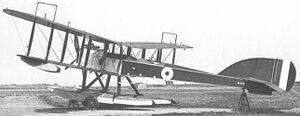Engineering:Wight Converted Seaplane
The Wight Converted Seaplane was a British twin-float patrol seaplane produced by John Samuel White & Company Limited (Wight Aircraft).
Design and development
Developed from the unsuccessful Wight Bomber for use as an anti-submarine patrol aircraft, the "Converted" Seaplane was a straightforward adaptation of the landplane bomber to a seaplane. The aircraft was a three-bay biplane with unswept, unequal span, unstaggered wings. It had twin floats under the fuselage and additional floats at tail and wings tips. Initial production aircraft were powered by a 322 hp Rolls-Royce Eagle IV engine mounted in the nose driving a four-bladed propeller, with later production batches being powered by a 265 hp (198 kW) Sunbeam Maori engine owing to shortages of Eagles.[1] Fifty were ordered for the RNAS, of which only 37 were completed.[2]
Operational history
The Converted Seaplane entered service with the RNAS in 1917,[1] operating from bases at Calshot, Dover, Portland and Cherbourg.[2] On 18 August 1917, a Wight Converted Seaplane flying from Cherbourg sank the German U-boat UB-32 with a single 100 lb bomb, the first submarine to be sunk in the English Channel by direct air action.[1] Seven remained in service with the RAF at the end of the First World War.
Operators
 United Kingdom
United Kingdom
- Royal Naval Air Service
- Royal Air Force
Specifications (Seaplane – Eagle engine)
Data from The British Bomber since 1914 [1]
General characteristics
- Crew: 2
- Length: 44 ft 8.5 in (13.627 m)
- Wingspan: 65 ft 6 in (19.96 m)
- Height: 16 ft 0 in (4.88 m)
- Wing area: 715 sq ft (66.4 m2)
- Empty weight: 3,758 lb (1,705 kg)
- Gross weight: 5,556 lb (2,520 kg)
- Powerplant: 1 × Rolls-Royce Eagle IV V-12 water-cooled piston engine, 322 hp (240 kW)
- Propellers: 4-bladed fixed-pitch propeller
Performance
- Maximum speed: 84 mph (135 km/h, 73 kn)
- Endurance: 3½ hours
- Service ceiling: 9,600 ft (2,900 m)
- Time to altitude: 6,500 ft (1,981 m) 18 min 20 sec
See also
Aircraft of comparable role, configuration and era
Related lists
- List of aircraft of the Fleet Air Arm
References
- The Illustrated Encyclopedia of Aircraft (Part Work 1982–1985). Orbis Publishing.
External links
- Wight Converted Seaplane – British Aircraft Directory
 |


